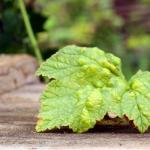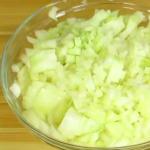
Ways to deal with the raspberry beetle
In summer, a black rim may appear on raspberries - a clear sign of damage to the plant by the raspberry beetle larva. The raspberry beetle is one of the main pests of raspberries. Its larvae, grayish-white or yellow-brown in color with a dark head, can destroy the entire raspberry crop, especially in wet years.
Description of the raspberry beetle
An adult individual of the pest is about 4 mm long, dense gray or yellow hairs are noticeable on the body, which are close to its body and give it a rusty-gray color, the elytra are grayish-black. After wintering, the raspberry beetle leaves the soil in late April - early May, when the temperature of the earth's surface reaches 12-15°C.
Raspberry damage
The pest damages the leaves and flowers of raspberries, and later settles in the berry itself. First, the beetle settles on weeds, on flowering trees and shrubs. Later, when it moves to raspberries, it feeds on its leaves, gnawing holes in them and leaving damage on the buds.  Photo: raspberry beetle
Photo: raspberry beetle
In raspberry flowers, pests eat nectaries and, most unpleasantly, lay eggs - white, elongated, about 1 mm long. At the same time, one female can lay eggs in 40 places - one egg in each ovary. After 10-12 days, the larvae of the raspberry beetle hatch and gnaw out tunnels in the pulp of the receptacle and seedlings.
The development of the larvae lasts about 1.5 months - just the period when the berries ripen, so the larvae are often found in the harvested crop. From damage to the caterpillars, the fruits turn black - more often at the base, the berries become dull, covered with mold or dry out, without having time to ripen.
In the first half of August, when the berry ripening period ends, the caterpillars fall to the ground and pupate in the soil. Moreover, only a part of the larvae pupate in the first year, others hibernate, and beetles appear from them a year later. The beetles hibernate at a depth of 15-20 cm without crawling to the surface.
How to deal with the raspberry beetle
1. First of all, in the spring, a chemical treatment should be carried out - immediately when the buds appear and no later than a week before the start of flowering. Of the insecticides used (per 10 liters of water) Fufanon , Kemithos , Iskra M (10 ml), spark (1 tab.), Fitoverm (20 ml), as well as Actellik (15 ml). The drugs of the first group are used at the rate of up to 2 liters per 10 bushes, and Actellik - 1.5 liters per 10 sq.m, maintaining the waiting time specified in the instructions before picking berries. Such solutions will also act against other raspberry pests that are dangerous to it precisely during the formation of buds.
2. Already during the appearance of buds, you can cover the bushes with a fine-mesh canopy or agril (lutrasilom etc.) - so the beetles will not get close to the raspberries. They remove the shelter only when at least 10% of the buds open.
3. Then, during the entire time of the ripening of the berries, it is necessary to carefully cultivate the soil in the raspberries: loosen the soil around the shoots with the addition of wood ash or tobacco dust.
4. Do not allow the site to be clogged - remove all unwanted plants in time.
5. It is necessary to constantly shake the beetles from the raspberries during the formation of buds. The procedure is recommended to be carried out in the first half of the day, using a wide container of water, a cloth or an open umbrella. After the pests burn.
6. During harvesting, rotten fruits should not be left on the bush. It is also better not to dump them on the ground, but to collect them in a separate container and throw them away outside the site.
7. In order for the beetle larvae not to remain on the berries during harvesting, you can put gauze or other material in a container where raspberries are harvested. The bulk of the larvae that crawl out of the berries will remain on the dense fabric, and they can be easily thrown away.
















